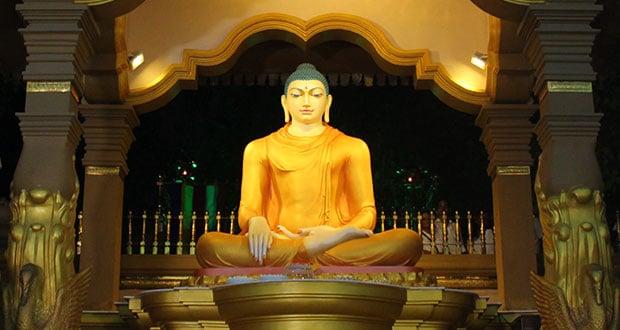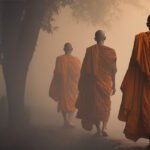Many are born to this world, but a few makes a difference, and a fewer still make a lasting impression. 2641 years ago a special event occurred in this world, the birth of prince Siddhartha. His first steps were greeted with lotuses that blossomed from beneath the ground and his first words spoke volumes of greatness to come.
Amidst luxuries one could only dream of, prince Siddhartha grew to be a fine prince, the heir to a Universal Monarch. At the age of 29 the sight of an old man, a sick person, a corpse and a wandering ascetic triggered within the prince the spark of wisdom that would one day shed light on the darkness that bespoke the ignorance that enveloped the world.
Shocked by the realization that every birth ends with aging, sickness, and death the prince began to contemplate on the utter futility of life. He couldn’t come to terms with why people being subject to aging themselves, would desire some other that is subject to aging, why people being subject to sickness themselves, would desire some other that is subject to sickness, why people being subject to death themselves, would desire some other that is subject to death as well. Steadfast in his resolve to emancipate from the mass of suffering that engulfed the world, prince Siddhartha renounced all luxuries and donned the robes of an ascetic and embarked on a quest to find a solution to the conundrum of life.
For six years ascetic Siddhartha Gautama practiced self-mortification and was convinced that neither self-mortification nor self-indulgence was the way to deliverance from suffering. Having abandoned the two extremes ascetic Siddhartha Gautama chose the “middle path” which he later taught as the “Noble Eightfold Path” and attained enlightenment.
It is by far the greatest achievement by any person in the history of mankind. The arising of a Buddha is so unique that the exceptionality of this occurrence can only be gauged by Buddha’s own words.
“Bhikkhus, there is one person who arises in the world for the welfare of many people, for the happiness of many people, out of compassion for the world, for the good, welfare and happiness of devas and human beings. Who is that one person? The Tathagata, the Arahant, the perfectly enlightened one. This is that one person who arises in the world for the welfare of many people, for the happiness of many people, out of compassion for the world, for the good, welfare and happiness of devas and human beings.”
“Bhikkhus, the emergence of one person is rare in the world. Who is that one person? The Tathagata, the Arahant, the perfectly enlightened one. Bhikkhus, the emergence of this one person is rare in the world.”
“Bhikkhus, there is one person arising in the world who is extraordinary. Who is that one person? The Tathagata, the Arahant, the perfectly enlightened one. Bhikkhus, this is that one person arising in the world who is extraordinary.”
Buddha’s first exposition of the Dhamma, the Dhammachakkapavattana sutta, meaning “Turning the wheel of Dhamma” took place at the Isipathana deer park in Benares. Ascetics Kondañña, Vappa, Bhaddiya, Mahanāma, and Assaji were the ones fortunate to listen to this first ever sutta by the Buddha. In the sutta, Buddha speaks of the realization gained through enlightenment and elaborates on his comprehension of the Four Noble Truths. Ascetic Kondañña and 80 million devas and brahmas realized the Dhamma by listening to the sutta. The sutta concludes with a passage that marks the significance of the occasion;
“So in that instant, at that very moment, the proclamation spread as far as the Brahma realm and the ten- thousandfold world system trembled and shook and resounded, and an immeasurable sublime radiance, surpassing the power of the devas, appeared in the world. Then the Blessed One uttered the pronouncement: “Indeed Kondañña has realized! Indeed Kondañña has realized!” And so it was that the name of Venerable Kondañña became “Kondañña who realized.”
Thus the wheel of Dhamma was set in motion, shedding light to the darkness of ignorance that consumed the world. This is further exemplified in the following sutta where Buddha likens himself to the sun and the moon that eliminates darkness.
“Bhikkhus, so long as the sun and moon have not arisen in the world, for just so long there is no manifestation of great light and radiance, but then blinding darkness prevails, a dense mass of darkness; for just so long day and night are not discerned, the month and fortnight are not discerned, the seasons and the year are not discerned.”
“But bhikkhus, when the sun and moon arise in the world, then there is the manifestation of great light and radiance; then there is no blinding darkness, no dense mass of darkness; then day and night are discerned, the seasons and year are discerned.”
“So too, bhikkhus, so long as a Tathagata, an Arahant, a Perfectly Enlightened One has not arisen in the world, or just so long there is no manifestation of great light (Dhamma) or radiance, but then blinding darkness (ignorance) prevails, a dense mask of darkness; for just so long there is no declaring, teaching, making known, establishing, disclosing, analyzing, explaining of the Four Noble Truths.”
“But, bhikkhus, when a Tathagata, an Arahant, a Perfectly Enlightened One arises in the world, then there is the manifestation of great light (Dhamma) and radiance, then no blinding darkness (ignorance) prevails, no dense mask of darkness; then there is the declaring, teaching, making known, establishing, disclosing, analyzing, explaining of the Four Noble Truths.”
Hence we should all strive to make the best of this opportunity by learning and practicing Dhamma as there is no deliverance from suffering unless we realize the Four Noble Truths. In “Kotigama Sutta” Buddha stated thus;
“It is bhikkhus, because of not understanding and not penetrating the Four Noble Truths that you and I have roamed and wandered through this long cause of samsara.”
“Now that the Four Noble Truths has been understood and penetrated, craving for existence has been cut off; the conduit to existence has been destroyed; now there is no renewed existence.”
Further Buddha encouraged us to spread the word of dhamma out of compassion, in the following manner;
“Bhikkhus, those for whom you have compassion, those who think you are worth listening to, whether friends, acquaintances or relatives, they should be encouraged in, introduced to and established in this Four Noble Truths.”
Buddha preached the Dhamma for 45 years and millions of fortunate humans and devas reaped the benefits of his noble endeavor by realizing the Four Noble Truths and ending the woeful cycle of rebirth. Even today a worldwide population of 1.6 billion practices Buddhism and incidents such as the following is evidence to the impact of Buddha’s teachings on the world at large.
Today, with organized religion increasingly used as a tool to separate and inflame rather than bringing together, a Geneva-based coalition created a “Best Religion in the World” award to inspire other religious leaders to see what is possible when you practice compassion. The award was voted on by an international round-table of more than 200 religious leaders from every part of the spiritual spectrum. To quote the words of the Director of the coalition;
“It was interesting to note that once we supplied the criteria, many religious leaders voted for Buddhism rather than their own religion,” “Buddhists actually make up a tiny minority of our membership, so it was fascinating but quite exciting that they won.”
However, according to the director, there was one snag. “Basically we can’t find anyone to give it to. All the Buddhists we call keep saying they don’t want the award.”
This clearly affirms, though Buddha passed away 2561 years ago the lasting impression he has made in the hearts of his disciples lives on; as they are aware the true reward of practicing Dhamma is none other than deliverance from suffering!
By a Venerable Thero of Mahamevnawa Meditation Monastery












Recent Comments